A Treatise on Botrytis Diseases of Strawberry and Caneberry
Introduction: A major purpose of this blog is to educate and inform on new emerging issues and developments in strawberries and caneberries. In addition, we also want to review and update common, well known issues that readers may be very familiar with. The following article is a review of a very important disease affecting the strawberry and caneberry industries: gray mold caused by Botrytis cinerea.
Causal Organism: Botrytis cinerea belongs to the fungal phylum Deuteromycota (sometimes also known as fungi imperfecti) and reproduces by forming asexual spores (conidia). The sexually reproducing stage has not been seen on strawberry or caneberry. The young mycelium of this fungus is septate, branched, and basically colorless. When this fungus is grown on potato dextrose agar, a common medium used to culture fungi, Botrytis cinerea is at first white and later turns gray as spores form. The spore producing structures are branched, up to 5 mm tall, and light to dark gray in color. Even under the low magnification of a dissecting microscope, one can readily see the distinctive “botryose” (Greek for bunch of grapes) clusters of spores at the ends of the spore-bearing branches (see sixth picture below).
Symptoms on Fruit: The rot from Botrytis is fairly simple to distinguish from the other fruit rots occurring in strawberries and caneberries. Generally, Botrytis rot will start as a light brown to gray spot (see third photo below) without any distinct margin around the affected area. This spot remains firm as it spreads and even a fruit completely rotten with Botrytis will retain its original shape. After a few days, if conditions are favorable (temperatures between 59o- 77oF), a brown to gray velvety growth will appear on the surface of the infected fruit.
Disease Cycle: Botrytis fruit infections on the Central Coast generally begin when the spore lands on the strawberry or caneberry flower. Given cooler temperatures and the presence of water, the spore germinates and infects the flower. If conditions are really favorable, the disease will progress in flower tissues and result in blighted blossoms that will no longer develop into fruit. Partial flower infections can cause brown lesions to form on the fruit receptacle; such flowers will not produce normal, fully developed fruit. In other cases the flower-invading Botrytis can become dormant and will not resume growing until fruit sugar content is more amenable for growth, at which point the disease will become evident from the brown lesion and subsequent gray velvety growth that occurs on the ripening fruit. If conditions become unfavorable for further disease development, Botrytis growth will stop and the lesion will become dry and leathery.
Because Botrytis is an aggressive colonizer of plant wounds, direct infection of the fruit can also occur if the fruit is injured from physical abrasion (rubbing caused by winds, for example), insect feeding, environmental extremes, other diseases, and other factors. Mature, ripe fruit are especially susceptible to infection because of their high sugar content and sensitive tissues. For this reason, Botrytis is an important component of post-harvest fruit losses.
Epidemiology: Botrytis spores (primary inoculum) are everywhere. The fungus grows well on senescent, dead tissues (old, dead strawberry stems and leaves; crop residues of other adjacent crops). Spores are blown by winds or splashed by rains onto flower and fruit tissues. It is important to note that the presence of free moisture for several consecutive hours is necessary for spore germination. Therefore, development of gray mold disease is greatest in cool and wet conditions, such as rain and the fog commonly experienced here on the Central Coast.
Control: Growers and managers should take a threefold approach to managing Botrytis gray mold in the field.
Fungicides: There is a substantial universe of fungicides available for the management of gray mold in strawberries and caneberries and a decent listing of these materials is available at the UC IPM website (http://www.ipm.ucdavis.edu/PMG/crops-agriculture.html). The key point for disease managers is to apply fungicides BEFORE major moisture events. As emphasized above, Botrytis spores need free moisture to germinate; therefore fungicides, which mostly act as protectants,should be in place before the occurrence of humidity and free moisture from rain or heavy fog . It is worth noting that the use of surfactants, which serve to better distribute fungicides over the plant surface as well as stabilize them, is strongly recommended with fungicide applications.
Sanitation: Removal of infected fruit from around the plant during the harvest season is helpful in reducing Botrytis gray mold potential, since each infected fruit produces millions of spores that can move onto nearby flowers and fruit. It is not necessary to remove fruit completely from the field; deposition of diseased fruit into the furrow and its periodic destruction by foot or machine traffic is sufficient. Additionally, removal of dead leaves on occasion can be of benefit because it removes another potential source of inoculum while at the same time maintaining more air circulation around the plant and keeping it drier.
Moisture management: Knowing that free moisture is critical to development of Botrytis grey mold gives managers a key tool in limiting development of this disease. For strawberries, planting so as to account for expected plant size and allowing for more air circulation is one step. It is worth noting that transplants can be chilled with an eye to managing plant size; short day varieties such as Chandler and Camarosa should not be chilled more than three days for most situations, and day neutral varieties such as Albion, San Andreas or Monterey generally should not be chilled more than 18 days. The use of drip irrigation, a universal practice in California, is essential for preventing irrigation water from contributing to favorable conditions for gray mold disease.
The use of macro-tunnels (also called high tunnels or Spanish tunnels) in caneberries results in a tremendous reduction of free moisture from rain or dew and a very real drop in the amount of gray mold disease to the extent that fungicide applications for Botrytis might be dispensed with entirely. There is no bigger step a caneberry grower can take to reduce Botrytis gray mold in their crop than to construct a macro-tunnel over it.
Before using any fungicide products, check with your local Agricultural Commissioner's Office and consult product labels for current status of product registration, restrictions, and use information.
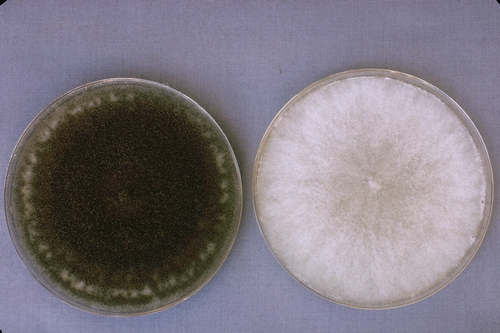
Botrytis cultures grown with light (left) and in complete darkness (right). Photo courtesy Steven Koike, UCCE
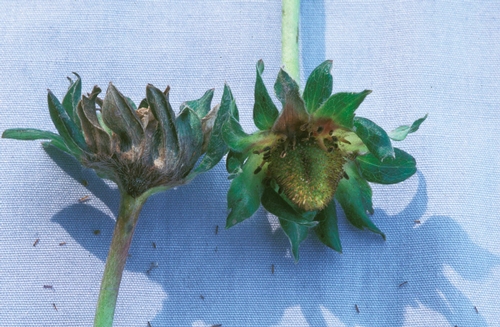
Gray mold lesions on calyces of developing fruit. Photo courtesy Steven Koike, UCCE.
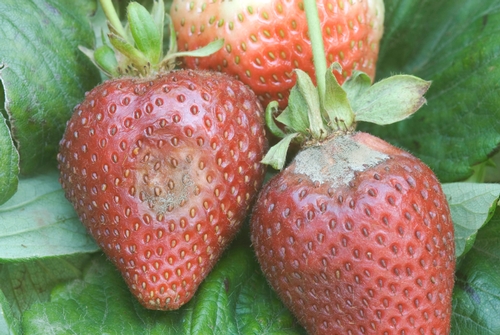
Early gray mold lesion on strawberry fruit. Photo courtesy Steven Koike, UCCE.
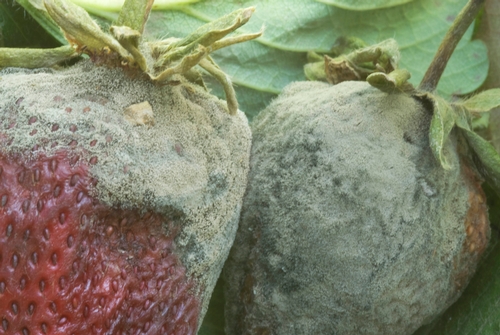
Extensive Botrytis sporulation on advanced gray mold of strawberry fruit. Photo courtesy Steven Koike, UCCE.
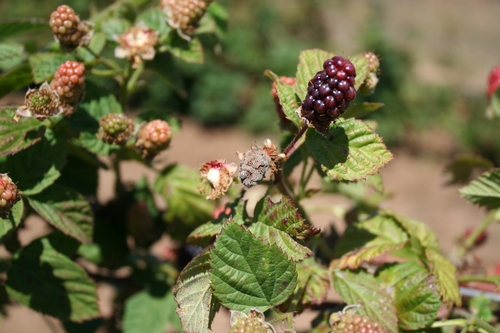
Botrytis infection on blackberry fruit. Fruit is desiccated and dried out. Photo Mark Bolda, UCCE Santa Cruz County.
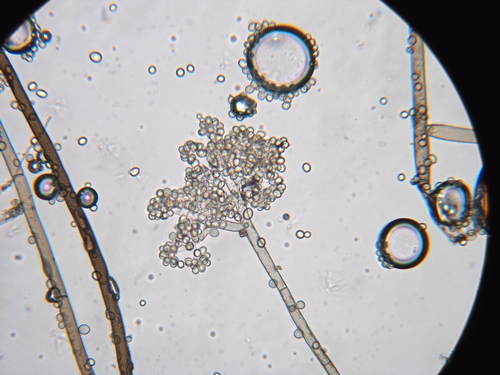
Clustered spores of Botrytis cinerea. Photo courtesy Steven Koike, UCCE.


Posted by Maxwell V. Norton on November 21, 2012 at 12:47 PM